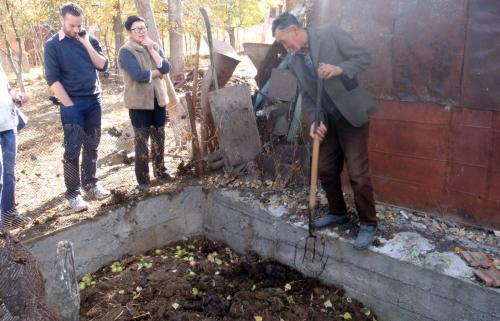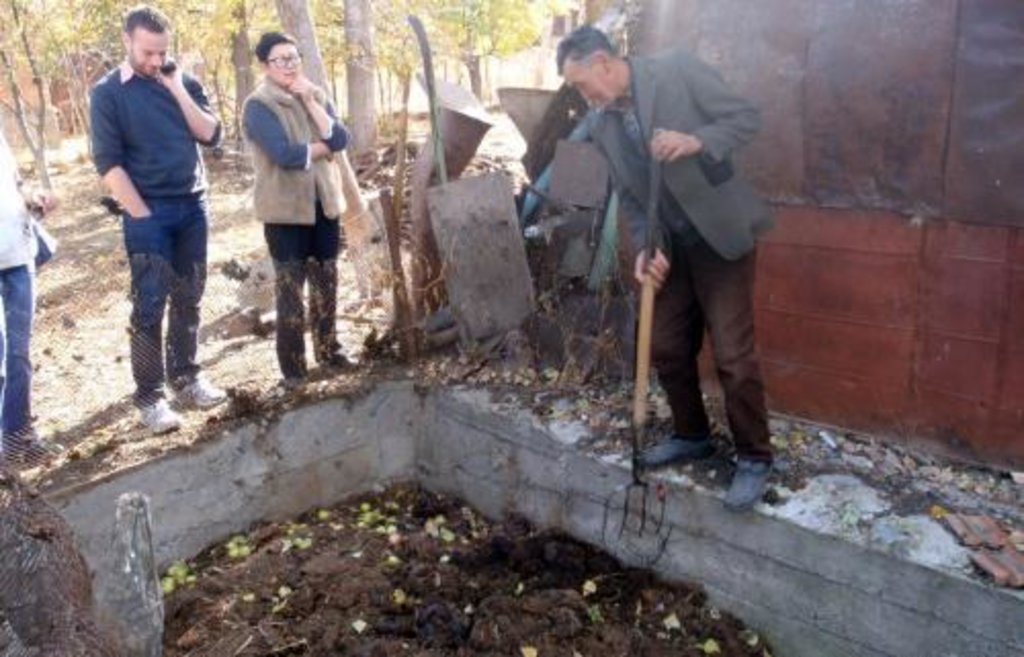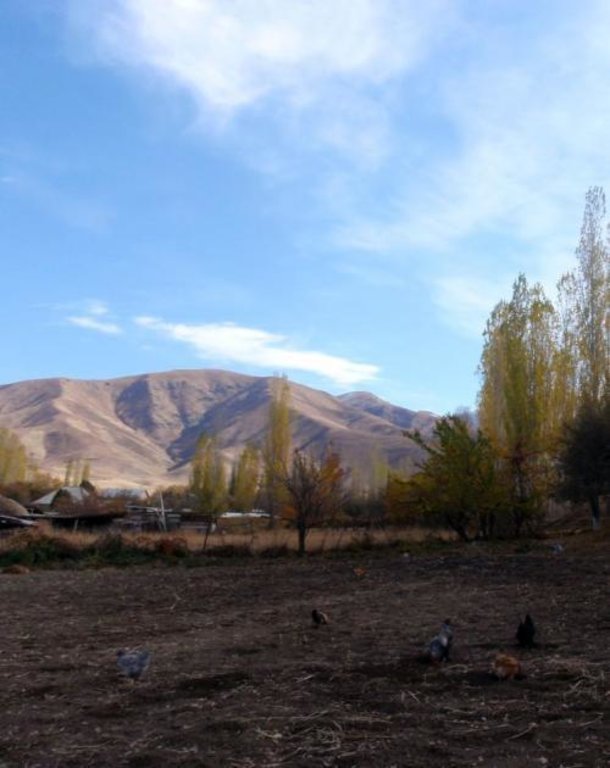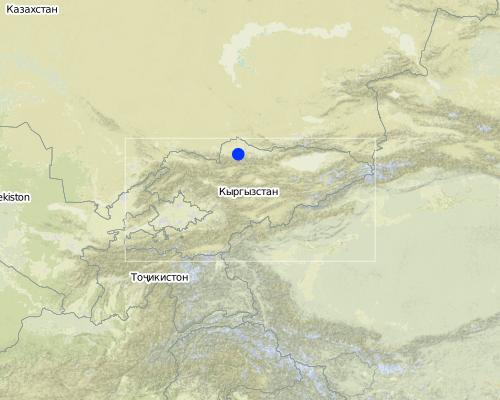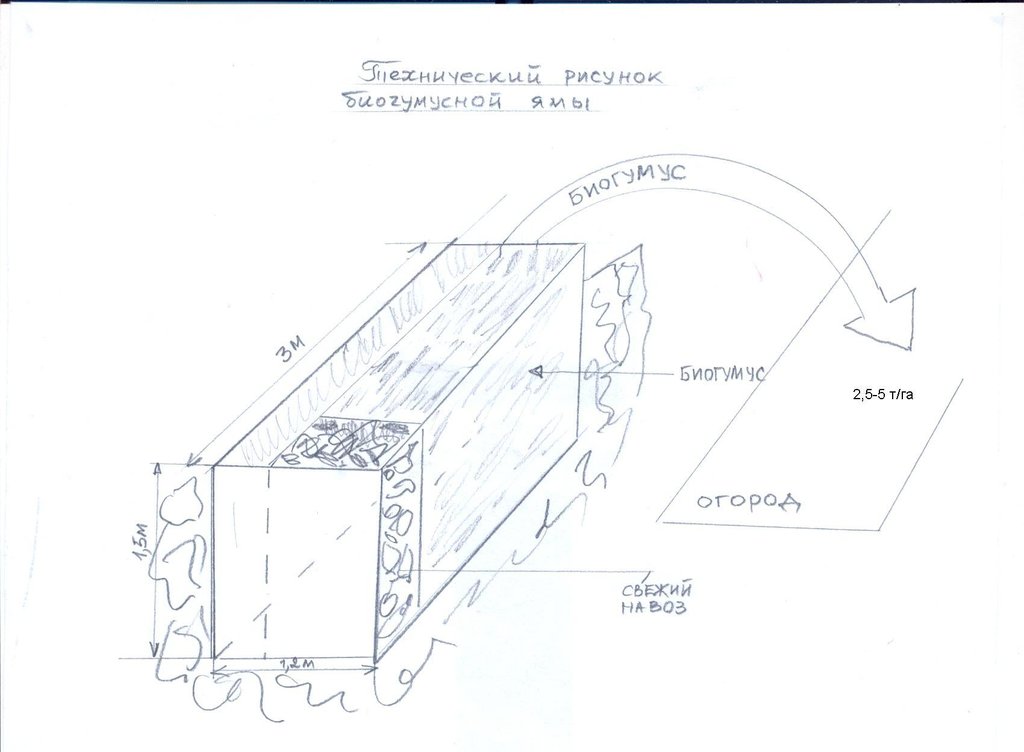Технология производства и применения биогумуса [Kyrgyzstan]
- Creation:
- Update:
- Compiler: Abdybek Asanaliev
- Editor: –
- Reviewer: Alexandra Gavilano
Биогумусту ондуруунун жана колдонуунун технологиясы
technologies_1125 - Kyrgyzstan
View sections
Expand all Collapse all1. General information
1.2 Contact details of resource persons and institutions involved in the assessment and documentation of the Technology
Name of the institution(s) which facilitated the documentation/ evaluation of the Technology (if relevant)
Kyrgyz Agrarian University (Kyrgyz Agrarian University) - Kyrgyzstan1.3 Conditions regarding the use of data documented through WOCAT
When were the data compiled (in the field)?
27/12/2011
The compiler and key resource person(s) accept the conditions regarding the use of data documented through WOCAT:
Ja
2. Description of the SLM Technology
2.1 Short description of the Technology
Definition of the Technology:
Биогумус или капролит получают в результате переработки свежего навоза красными калифорнийскими червями, размещая их специальной траншее, заполненный навозом.
2.2 Detailed description of the Technology
Description:
С 90-х годов прошлого века в селе Борулу в огородах не применяют минеральные удобрения из за высокой их стоимости. В результате этого естественное плодородие почв снижается.
Осознавая ситуацию, глава домохозяйства Калмурат Кошалиев решил заниматься производством и применением биогумуса. Для переработки навоза вырыта траншея длиной 3 метра, шириной 1,2 и глубиной 1,5 метра. Траншея облицована бетоном, но дно траншеи не бетонировано. Края траншеи огорожены сеткой, для защиты червей от домашних птиц. После осушки бетона в мае месяце в траншею загрузили свежего навоза высотой 30 см и выпустили 5 кг калифорнийских червей. Калифорнийские черви питаются навозной органикой и активно перерабатывают ее. В жаркое время года навозная масса должна быть влажной и поэтому ее нужно поливать в неделю один раз придавая навозу 60-70 % влажности. В течение 20-25 дней черви свежий навоз перерабатывают, при этом навоз приобретает темную окраску и рассыпчатую структуру. В результате повышения температуры в навозе, находящееся там семена сорной растительности теряют всхожесть. Биогумус отделяют от червей через металлическую сетку, масса падает вниз черви остаются на сетке. Отделенных червей пускают на другой конец транши, вынимаемую часть заполняют свежим навозом высотой 50 см. Так цикл повторяется каждые 20-25 дней до наступления холодов. С наступлением холодов поверхность укрывают соломой, листьями высотой 30 см для утепления и чтобы не допустить промерзания массы зимой. Весной снова цикл повторяется. При чрезмерном размножении червей их отделяют и создают другие места производства. Переработанную массу фермер применяет, как органическое удобрение под картофель, морковь, помидоры. Нормы внесения биогумуса в расчете на 1 га составляет 2,5-5 тонн. В результате систематического внесения биогумуса структура почвы фермерского участка значительно улучшилась.
Purpose of the Technology: Смягчение снижения плодородия почвы через внесения в почву органического удобрения (биогумуса).
Establishment / maintenance activities and inputs: Применение технологии стало возможным после обучающего семинара - «Устойчивое использование природных ресурсов через почво и водосберегающие технологии», организованный Общественным Фондом (ОФ) «САMP-Алатоо». В ходе семинара, сами участники из села Тош-Булак, Четинди и Борулу используя коллекций почво и водосберегающих технологий (ПВСТ) от «САMP-Алатоо» разработали свои проекты ПВСТ. Одну из этих групп участников возглавила Калмурат Кошалиев и разработали проект технологии производства биогумуса. Эта группа вносила свой трудовой и финансовый вклад на внедрение технологии и в то же время (ОФ) «САMP-Алатоо» финансировал часть затрат. Но общую сумму денег группа закупила калифорнийских червей и цемент для облицовки траншеи. Все затраты на содержания технологии производства биогумуса и внесения на огороде несет сами домохозяйства.
Natural / human environment: Земли села Борулу расположены на высоте 1600-1630 метров над уровнем моря в ущелье Сокулук северного склона Кыргызского хребта. Огородные участки расположены у подножья гор. Горы покрыты кустарниково-арчовым лесом. Производственная деятельность жителей в основном сосредоточена на животноводстве. Животных пасут на присельных, интенсивных пастбищах. Имеется также отгонные пастбища, расположенные в Суусамырской долине. Присельные пастбища используются в круглый год. Животных подкармливают в зимнее время сеном и концентрированными кормами. На огородных участках выращивают картофеля, моркови и чеснока. Урожай картофеля в расчете на 1 га доходит до 350 – 400 ц, где применяют удобрения. Почвы светло-каштановые и каштановые, формирующиеся на глинсто-супесчанных и хрящеватых галечниках. Структура почвы способствует получению хороших урожаев сельскохозяйственных культур.
2.3 Photos of the Technology
2.5 Country/ region/ locations where the Technology has been applied and which are covered by this assessment
Country:
Kyrgyzstan
Region/ State/ Province:
Кыргызская Республика
Further specification of location:
Сокулукский район, Чуйская область
Map
×2.6 Date of implementation
If precise year is not known, indicate approximate date:
- more than 50 years ago (traditional)
2.7 Introduction of the Technology
Specify how the Technology was introduced:
- through projects/ external interventions
3. Classification of the SLM Technology
3.2 Current land use type(s) where the Technology is applied

Cropland
- Annual cropping
Comments:
Major land use problems (compiler’s opinion): Снижение плодородия почвы.
Major land use problems (land users’ perception): Повышение цен на удобрения, пестициды, семена и ухудшение земель.
3.3 Further information about land use
Number of growing seasons per year:
- 2
Specify:
Longest growing period in days: 140
Longest growing period from month to month: с мая по сентябрь
Second longest growing period in days: 150
3.5 Spread of the Technology
Comments:
Общая площадь технологии УУЗР: 0.10 га
3.6 SLM measures comprising the Technology

agronomic measures
- A2: Organic matter/ soil fertility
Comments:
Main measures: agronomic measures
Type of agronomic measures: навоз / компост / остатки
3.7 Main types of land degradation addressed by the Technology

chemical soil deterioration
- Cn: fertility decline and reduced organic matter content (not caused by erosion)
Comments:
Main type of degradation addressed: Ха (Cn): снижение плодородия почвы и органических веществ в почве (не вызванные эрозией)
Main causes of degradation: управление с/х культурами (однолетние, многолетние, деревья/кустарники) (Отсутствие севооборотов и применения удобрений.), интенсивная эксплуатация населением (Отсутствие парующих земель, незначительные вклады на поддержание плодородия почвы.)
Secondary causes of degradation: бедность / богатство (Не способность жителей покупать агрохимикатов из за высоких цен.), образование, доступ к знаниям и поддерживающие услуги (Отсутствие специальных знаний об использовании сельскохозяйственных земель и не развитость консультационных служб.)
3.8 Prevention, reduction, or restoration of land degradation
Specify the goal of the Technology with regard to land degradation:
- reduce land degradation
Comments:
Main goals: mitigation / reduction of land degradation
4. Technical specifications, implementation activities, inputs, and costs
4.1 Technical drawing of the Technology
4.2 Technical specifications/ explanations of technical drawing
В рисунке указана схема траншеи для производства биогумуса
Location: село Борулу. Чуйская область
Date: 27/12/2011
Technical knowledge required for field staff / advisors: высокий
Technical knowledge required for land users: средний
Main technical functions: повышение органического вещества
Manure / compost / residues
Material/ species: Органическое удобрение (биогумус)
Quantity/ density: 2,5-5 тонн
Remarks: Нормы зависят от вида культур и высоты планируемого урожая
4.3 General information regarding the calculation of inputs and costs
other/ national currency (specify):
кыргызский сом
Indicate exchange rate from USD to local currency (if relevant): 1 USD =:
40.0
Indicate average wage cost of hired labour per day:
12.00
4.5 Costs and inputs needed for establishment
| Specify input | Unit | Quantity | Costs per Unit | Total costs per input | % of costs borne by land users | |
|---|---|---|---|---|---|---|
| Labour | None | None | 5.0 | 50.0 | 250.0 | 100.0 |
| Construction material | None | None | 5.0 | 50.0 | 250.0 | 50.0 |
| Other | None | None | 5.0 | 10.0 | 50.0 | 100.0 |
| Total costs for establishment of the Technology | 550.0 | |||||
Comments:
Duration of establishment phase: 2 month(s)
4.7 Costs and inputs needed for maintenance/ recurrent activities (per year)
| Specify input | Unit | Quantity | Costs per Unit | Total costs per input | % of costs borne by land users | |
|---|---|---|---|---|---|---|
| Labour | None | 1.0 | 38.0 | 38.0 | 100.0 | |
| Total costs for maintenance of the Technology | 38.0 | |||||
4.8 Most important factors affecting the costs
Describe the most determinate factors affecting the costs:
На затраты влияет объем траншеи, нормы внесения биогумуса на участок, частота отбора биогумуса из траншеи.
5. Natural and human environment
5.1 Climate
Annual rainfall
- < 250 mm
- 251-500 mm
- 501-750 mm
- 751-1,000 mm
- 1,001-1,500 mm
- 1,501-2,000 mm
- 2,001-3,000 mm
- 3,001-4,000 mm
- > 4,000 mm
Agro-climatic zone
- semi-arid
Thermal climate class: temperate. Умеренная зона, ясно выраженным четырьмя сезонами
5.2 Topography
Slopes on average:
- flat (0-2%)
- gentle (3-5%)
- moderate (6-10%)
- rolling (11-15%)
- hilly (16-30%)
- steep (31-60%)
- very steep (>60%)
Landforms:
- plateau/plains
- ridges
- mountain slopes
- hill slopes
- footslopes
- valley floors
Altitudinal zone:
- 0-100 m a.s.l.
- 101-500 m a.s.l.
- 501-1,000 m a.s.l.
- 1,001-1,500 m a.s.l.
- 1,501-2,000 m a.s.l.
- 2,001-2,500 m a.s.l.
- 2,501-3,000 m a.s.l.
- 3,001-4,000 m a.s.l.
- > 4,000 m a.s.l.
5.3 Soils
Soil depth on average:
- very shallow (0-20 cm)
- shallow (21-50 cm)
- moderately deep (51-80 cm)
- deep (81-120 cm)
- very deep (> 120 cm)
Soil texture (topsoil):
- coarse/ light (sandy)
Topsoil organic matter:
- medium (1-3%)
5.4 Water availability and quality
Availability of surface water:
good
Water quality (untreated):
good drinking water
5.5 Biodiversity
Species diversity:
- medium
5.6 Characteristics of land users applying the Technology
Off-farm income:
- less than 10% of all income
Individuals or groups:
- individual/ household
Gender:
- women
- men
Indicate other relevant characteristics of the land users:
Land users applying the Technology are mainly disadvantaged land users
Population density: < 10 persons/km2
Annual population growth: 2% - 3%
2% of the land users are rich and own 7% of the land.
78% of the land users are average wealthy and own 85% of the land.
20% of the land users are poor and own 8% of the land.
Off-farm income specification: Те, которые не применяют УУЗР, занимаются животноводством или занимаются частным извозом.
5.7 Average area of land owned or leased by land users applying the Technology
- < 0.5 ha
- 0.5-1 ha
- 1-2 ha
- 2-5 ha
- 5-15 ha
- 15-50 ha
- 50-100 ha
- 100-500 ha
- 500-1,000 ha
- 1,000-10,000 ha
- > 10,000 ha
Is this considered small-, medium- or large-scale (referring to local context)?
- small-scale
5.8 Land ownership, land use rights, and water use rights
Land ownership:
- individual, titled
Land use rights:
- individual
Water use rights:
- open access (unorganized)
5.9 Access to services and infrastructure
health:
- poor
- moderate
- good
education:
- poor
- moderate
- good
technical assistance:
- poor
- moderate
- good
employment (e.g. off-farm):
- poor
- moderate
- good
markets:
- poor
- moderate
- good
energy:
- poor
- moderate
- good
roads and transport:
- poor
- moderate
- good
drinking water and sanitation:
- poor
- moderate
- good
financial services:
- poor
- moderate
- good
6. Impacts and concluding statements
6.1 On-site impacts the Technology has shown
Socio-economic impacts
Production
crop production
Quantity before SLM:
150 ц/га
Quantity after SLM:
250ц/га
Income and costs
expenses on agricultural inputs
Quantity before SLM:
0
Quantity after SLM:
20
farm income
Quantity before SLM:
0.%
Quantity after SLM:
20%
Socio-cultural impacts
health situation
Quantity before SLM:
10%
Quantity after SLM:
20%
cultural opportunities
Quantity before SLM:
0 га
Quantity after SLM:
0,10 га
community institutions
Quantity before SLM:
0
Quantity after SLM:
Создана1гр
conflict mitigation
Quantity before SLM:
0
Quantity after SLM:
4чел. обуч
Ecological impacts
Biodiversity: vegetation, animals
biomass/ above ground C
Climate and disaster risk reduction
fire risk
Quantity before SLM:
2%
Quantity after SLM:
10%
6.2 Off-site impacts the Technology has shown
buffering/ filtering capacity
Quantity before SLM:
30 %
Quantity after SLM:
50%
6.3 Exposure and sensitivity of the Technology to gradual climate change and climate-related extremes/ disasters (as perceived by land users)
Gradual climate change
Gradual climate change
| Season | Type of climatic change/ extreme | How does the Technology cope with it? | |
|---|---|---|---|
| annual temperature | increase | not well |
Climate-related extremes (disasters)
Climatological disasters
| How does the Technology cope with it? | |
|---|---|
| drought | not well |
6.4 Cost-benefit analysis
How do the benefits compare with the establishment costs (from land users’ perspective)?
Short-term returns:
neutral/ balanced
Long-term returns:
positive
How do the benefits compare with the maintenance/ recurrent costs (from land users' perspective)?
Short-term returns:
positive
Long-term returns:
positive
Comments:
Краткосрочный период: 1 - 3 года; долгосрочный период: 10 лет
6.5 Adoption of the Technology
Comments:
10% of land user families have adopted the Technology with external material support
1 land user families have adopted the Technology with external material support
Comments on acceptance with external material support: В селе размещены 30 участков (домов). Из них 1 владелец применили эту технологию. Всего пригодный для освоения участок 10 га.
6% of land user families have adopted the Technology without any external material support
2 land user families have adopted the Technology without any external material support
Comments on spontaneous adoption: Два домохозяйства из 30 применили эту технологию на площади ) 0,20 га (0,10+0,10 га) из 10 га возможных площадей.
There is a little trend towards spontaneous adoption of the Technology
6.7 Strengths/ advantages/ opportunities of the Technology
| Strengths/ advantages/ opportunities in the land user’s view |
|---|
|
появилась возможность повышения урожая растений, и показать людям технологию How can they be sustained / enhanced? Пока осознаешь необходимость получения больших урожаев |
| Strengths/ advantages/ opportunities in the compiler’s or other key resource person’s view |
|---|
|
смягчение деградации земель через увеличение содержания органической массы почвы How can they be sustained / enhanced? Пока люди осознают необходимость внесения удобрений. |
|
повышение урожайности культуры How can they be sustained / enhanced? Пока люди ухаживают за участком. |
6.8 Weaknesses/ disadvantages/ risks of the Technology and ways of overcoming them
| Weaknesses/ disadvantages/ risks in the land user’s view | How can they be overcome? |
|---|---|
| поддержание производства отнимает много времени | Учить своих детей и заключать договора с соседями на получение удобрения. |
| Weaknesses/ disadvantages/ risks in the compiler’s or other key resource person’s view | How can they be overcome? |
|---|---|
| слабое принятие технологии | Обучать людей к технологии |
7. References and links
7.2 References to available publications
Title, author, year, ISBN:
Отчеты и протоколы семинара «ОФ САМР-Алатоо»,
Available from where? Costs?
Офис «ОФ САМР-Алатоо»
Title, author, year, ISBN:
Отчеты «ОФ САМР-Алатоо» по мониторингу и оценке внедренных ПВСТ в селе Саз
Title, author, year, ISBN:
Документы домашнего архива Калмурата Кошалиева.
Available from where? Costs?
Библиотека Кыргызского НИИ Земледелия.
Title, author, year, ISBN:
Абасов В.С. Влияние биогумуса на продуктивность сельскохозяйственных культур на сероземных почвах Чуйской долины.- Автореферат диссертации на соискание ученой степени кандидата сельскохозяйственных наук.- Бишкек, 2002.
Available from where? Costs?
Библиотека Кыргызского НИИ Земледелия.
Links and modules
Expand all Collapse allLinks
No links
Modules
No modules


